Dentures make life easier every day. While you may miss your natural teeth, dentures make it possible for you to eat well, improve your appearance, fill gaps where natural teeth are missing and support your facial muscles so you maintain your appearance. Dentures require special care, however, and so does the rest of your mouth. Daily cleaning and regular dental visits are just as important now that you are a denture wearer as they were before you got your dentures.


 Dentures are removable replacements for missing teeth typically made out of an acrylic resin which at times incorporate porcelain or metal for additional structural support. There are two main types of dentures. Both Complete Dentures and Partial Dentures are finely crafted, custom-fitted. If you properly maintain your dentures they will appear natural and provide a perfect smile. Additionally, dentures help strengthen muscles controlling your expressions that require the support of your teeth, rid you of pronunciation problems caused by missing teeth and aid with chewing.
Complete dentures can be either "conventional" or "immediate." Made after the teeth have been removed and the gum tissue has begun to heal, a conventional denture is ready for placement in the mouth about 8 to 10 weeks after the teeth have been removed.
Unlike Conventional Dentures, Immediate Dentures are made in advance and can be positioned as soon as the teeth are removed. As a result, the wearer does not have to be without teeth during the healing period. However, bones and gums shrink over time, especially during the healing period following tooth removal. Therefore a disadvantage of immediate dentures compared with conventional dentures is that they require more adjustments to fit properly during the healing process and generally should only be considered a temporary solution until conventional dentures can be made
Dentures are removable replacements for missing teeth typically made out of an acrylic resin which at times incorporate porcelain or metal for additional structural support. There are two main types of dentures. Both Complete Dentures and Partial Dentures are finely crafted, custom-fitted. If you properly maintain your dentures they will appear natural and provide a perfect smile. Additionally, dentures help strengthen muscles controlling your expressions that require the support of your teeth, rid you of pronunciation problems caused by missing teeth and aid with chewing.
Complete dentures can be either "conventional" or "immediate." Made after the teeth have been removed and the gum tissue has begun to heal, a conventional denture is ready for placement in the mouth about 8 to 10 weeks after the teeth have been removed.
Unlike Conventional Dentures, Immediate Dentures are made in advance and can be positioned as soon as the teeth are removed. As a result, the wearer does not have to be without teeth during the healing period. However, bones and gums shrink over time, especially during the healing period following tooth removal. Therefore a disadvantage of immediate dentures compared with conventional dentures is that they require more adjustments to fit properly during the healing process and generally should only be considered a temporary solution until conventional dentures can be made
 A conventional over-denture rests over some healthy natural tooth roots.
A conventional over-denture rests over some healthy natural tooth roots.


With Complete Dentures – Happy Patient



Partial Dentures
A removable partial denture or bridge usually consists of replacement teeth attached to a pink or gum-colored plastic base, which is connected by metal framework that holds the denture in place in the mouth. Partial dentures are used when one or more natural teeth remain in the upper or lower jaw. A fixed (permanent) bridge replaces one or more teeth by placing crowns on the teeth on either side of the space and attaching artificial teeth to them. This "bridge" is then cemented into place. Not only does a partial denture fill in the spaces created by missing teeth, it prevents other teeth from changing position. A precision partial denture is removable and has internal attachments rather than clasps that attach to the adjacent crowns. This is a more natural-looking applianceHow Are Dentures Made?
The denture development process takes about one to two weeks and some appointments. Once your Dentist or Prosthodontist (a dentist who specializes in the restoration and replacement of teeth) determines what type of appliance is best for you, the general steps are to:- Make a series of impressions of your jaw and take measurements of how your jaws relate to one another and how much space is between them
- Create models, wax forms, and/or plastic patterns in the exact shape and position of the denture to be made. You will "try in" this model several times and the denture will be assessed for color, shape, and fit before the final denture is cast.
- Cast a final denture
- Adjustments will be made as necessary
Tooth supported overdentures

An overview of the Jaw
Maintaining a denture on the jaw bone ridge (called alveolar ridge) is essential to preventing it from becoming loose during eating, speaking and other activities. Preserving the alveolar ridge facilitates denture stability. The body tends to conserve energy and nutrients by maintaining only structures with apparent. immediate value. A typical example is the bulk reduction of a broken leg held immobile by a full leg cast for a month or more. The body "recognizes" the only one purpose for alveolar bone is to hold tooth roots. Alveolar bone no longer supporting a tooth root is removed, or literally dissolved away by the body. This is called resorption or simply shrinkage. Resorption progresses at varying rates in the same person at different times and at different rates between different people. Resorption progresses rapidly within the first year of loosing a tooth after which time the rate progresses at a slower pace.Preserving the Jaw bone
If the maximum amount of bone is to be maintained then preserving the maximum number of healthy tooth roots should achieve that end.Preserving the sensation of having teeth
Studies demonstrate that even though only roots are preserved, and they are covered by a denture, a patient still has sensory input sensations similar to that experienced with teeth, as opposed to individuals with conventional dentures having no preserved roots. Over-denture patients also appear to have a more natural perceived directional sense in their chewing activities. In other words, many patients relate that they still feel like they have teeth - - a positive comment.Why an Over-denture?
If a patient is treatment planned to have a denture, and the roots of some remaining teeth are supported in healthy alveolar bone - - then a conventional over-denture is a viable consideration. However, only a licensed dental professional A Prosthodontist can determine if a conventional over-denture is a suitable consideration for a certain person, after a comprehensive examination.Some characteristics of a Tooth Supported Over-denture
Most of a tooth crown (that part of the tooth above the gums) is removed. This often necessitates root canal therapy if not already done. Remaining tooth, projecting above the gum, is rounded and usually covered with a similarly shaped artificial crown-like covering. Various configurations and extensions may be built onto some retained roots. In those cases, that portion of the denture overlying these configurations is modified to contain attachments that clip onto a framework or receive the individual extensions. In addition to preserving alveolar bone and sensory input, the denture is securely held in place, but may be comfortably and easily removed for cleaning.Advantages of a Tooth Supported Over-denture
-
- Feels more like having teeth
- More retentive in many cases
- Helps reduce shrinkage of surrounding bone
- Reduces pressure to portions of the alveolar ridge
- Positive psychological advantage of still having teeth
Disadvantages of a Tooth Supported Over-denture
There is Practically No Disadvantage-
-
- Meticulous oral hygiene is essential in order prevent decay and gum disease.
- Frequent maintenance examinations are necessary.
-
Implant supported overdentures

A dental implant over-denture connects to cylinder-like configurations (called implants) that have been surgically implanted into the jawbone.
The dental implant denture appears like a traditional prosthesis. However, the part of the denture overlying the dental implants is modified to retain various semi-rigid attachments that receive dental implant extensions projecting above the gum. This arrangement helps keep a denture securely in place while eating, speaking, and during other oral activities, but still allows easy self-removal of the denture for cleaning purposes.
There are two phases to this process. The first is a surgical phase consisting of two stages, and the second is a prosthetic phase (making the implant denture).
The Surgical Phase of Dental Implants
1. Surgical Implant Insertion Stage- Dental implants are completely inserted into precise preparations in the jawbone. While there are various dental implant configurations, they are essentially cylindrical in shape and made of pure titanium metal. After dental implants are inserted into the jawbone, gum tissue over the dental implant is closed with sutures, in most cases
- While a minimum of two dental implants may be inserted for barely an acceptable outcome, a person may plan to receive up to 8 implants per jaw, depending upon his/her anatomical limitations. More dental implants will give additional support and retention to the dental implant denture, Finally a very Successful Implant Supported Denture.
- During healing, an existing or temporary denture may continue to be worn after adjustments have been made to adapt it to the surgical site. If the existing denture cannot be altered sufficiently, a provisional prosthesis should be fabricated.
- Dental implants are left undisturbed beneath gum tissue for at least several months as determined by the dentist. During this time, bone reorganizes and grows around the dental implant surface, anchoring it securely into the jaw (this is called osseointegration).
- At the end of the healing stage, the top of the dental implant is exposed by removing gum tissue directly over it. An extension that is then screwed into the exposed dental implant projects slightly above the gum tissue.
- After adjustments, an existing denture can be worn over an dental implant denture extension while the gum heals. However, the denture must be reshaped to conform to surgical site contours in order to avoid unnecessary pressure areas on the newly inserted extensions and the surgical area.
The Prosthetic Phase (Making the Dental Implant Dentures)
- A precision superstructure is fabricated and is screwed into the dental implant extensions. This superstructure may have various interface configurations, ranging from interconnecting metal bars to specially shaped singular extensions.
- A dental implant denture is fabricated with special provisions on the inside surface to receive various types of attachments (interlocks). Depending on the attachment, they interact in various ways with the superstructure. For example, a metal or plastic attachment may clip onto metal superstructure bars, a nylon receptacle may receive a specially configured dental implant extension, etc.
- The attachment/superstructure configuration helps to securely maintain a denture while eating and speaking, and still allows a person to comfortably and easily remove the prosthesis for cleaning purposes.
Essential Dental Implant Dentures Maintenance Needs
As might be expected, exemplary oral hygiene is essential to help prevent the development of disease around Dental Implant Dentures that could cause their failure. Implants, superstructure, attachments, and the over-denture must be checked and professionally maintained by a Implant Specialist like Dr. Somesh Grover on a regular basis. While the Dental Implant Over-denture approach is complex and little expensive, the Value received by an individual usually far exceeds monetary considerations.How Long Will Dental Implant Dentures Last?
Dental implant dentures may last for a lifetime (current reports show many dental implants lasting 20 years) or deteriorate in a few years. Many factors are involved that reduce the life expectancy of dental implants, such as poor oral hygiene, compromised general health, bad habits such as smoking, night or day grinding, etc. The superstructure or dental implant extensions may need to be replaced after two to five years depending on the dental implant system used, because of wear or deterioration. These time frames are generalities. At Dr. Grover’s Dental Clinic we continue to strive for long-term durability of dental implant dentures.Flexible dentures (Valplast)
These are special flexible acrylic partial dentures indicated in certain specific situations and are very comfortable to wear and remove by the user. Flexible partial dentures are the comfortable, beautiful, and affordable choice. The innovation of the Flexible Partial allows the restoration to adapt to the constant movement and function in your mouth. The flexibility, combined with strength and light weight, provides total comfort and great looks !
The preparation is relatively simple because your natural teeth don't need to be altered in any way. This partial denture is virtually invisible because there are no telltale metal clasps and the material itself blends with the tissue in your mouth so that the only thing that shows is your beautiful smile.
When considering a removable partial, many people find this Flexible Partial to be the most comfortable option and the final restoration can be made very quickly. Also this flexible partial involves only non-invasive procedures, and gives you confidence in your restoration while talking, eating, and most importantly:




